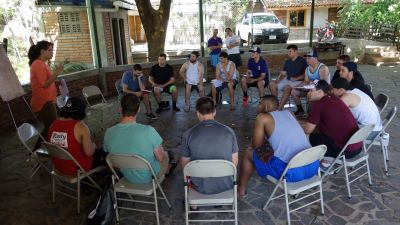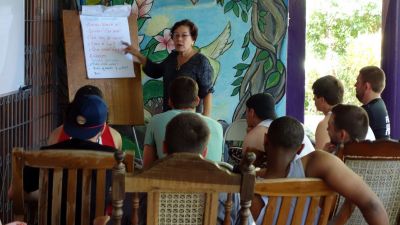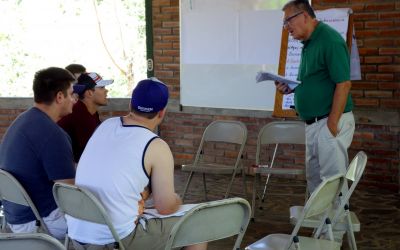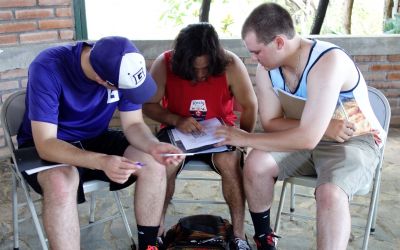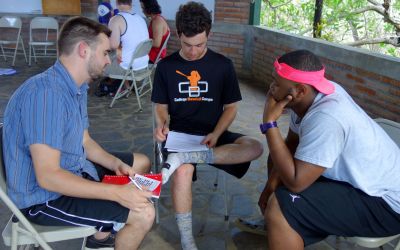We woke up to the sounds of unfamiliar birds that started singing before the sun came up (which is at 5:20 here). Breakfast at 8:00 included tortillas, scrambled eggs, beans, and fresh orange juice. Following breakfast we had a group “check in” for everyone to share their first impressions since arriving in the country. Some noted the heat, others noted the busy excitement on the streets while driving through Managua the previous night.
The day was filled with a series of informational meetings, Spanish classes, and free time for either exploring the streets around the retreat center or taking a nap. Maria (co-leader, Spanish professor at Goshen, and Nicaraguan since birth) began the meetings by teaching the students about ways Nicaraguans communicate non-verbally, the Nicaraguan use of nicknames for referring to others, and common greetings. Doug (co-leader, chemistry professor at GC, and resident of Nicaragua for 15 years), explained the first course assignment in Nicaragua, to find out the cost of living for their Nicaraguan host families. Students will make a list of common foods and supplies their families buy each week, and later they will visit the open-air market to ask the prices of the supplies, so that they can estimate the total cost of basic necessities for a week.
Part of the day’s activities included 2 hours of work with Spanish instructors. This lessons and others to follow in the coming weeks focus on helping the students verbalize the essential things they need to communicate with their families. For Sunday night that will include introducing themselves to their Nicaraguan host families.
Halfway through the Spanish classes we took a break for a thirst-quencher: a drink made from rice and pineapple. Nicaragua has many sweetened drinks, called frescos, that they make from fruits, grains or combinations of both. This includes fruits commonly found in the U.S. supermarkets (e.g. pineapples, bananas, oranges, grapefruit, lemons, mangoes, watermelons and melons), fruits more commonly found only in the tropics (e.g. guava, passion fruit, tamarind, pitahaya, and granadilla), and grains such as oatmeal, rice, corn, and barley. For lunch the students had their first taste of the fresco made from tamarinds.
After lunch the students had free time to explore the surrounding streets or just take a siesta from the mid-day heat, which was in the low 90’s today. Hearing that it was in the 40’s back in Goshen helped us to not complain so much about the heat.
In the afternoon the students took a history quiz based on readings assigned before they came to Nicaragua. Part of the grade came from individual attempts at the multiple choice quiz, and part of the grade came from working in groups to collectively arrive at the right answers, using ‘scratch and reveal’ lottery-type cards where the students get more points for getting the right answers with fewer guesses. Afterwards we constructed a Nicaraguan timeline of important dates stretching back to the first indigenous groups that arrived here around 6,000 B.C.
The rest of the afternoon meetings dealt with essential safety and health information for travelers in Nicaragua, and then students again had some free time before supper. Another ‘check-in’ followed supper, and then Maria gave out the much-anticipated family assignments, giving the names of their host parents, the number of siblings, and the locations of their homes for the next 3 weeks.
